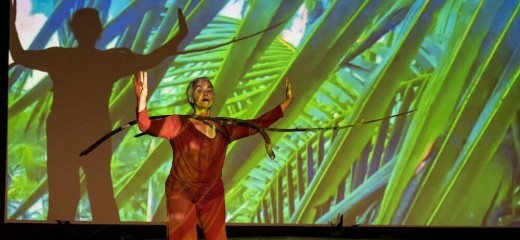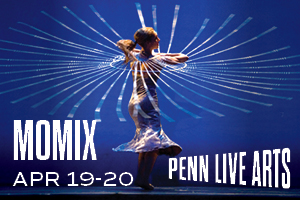
The World Will Never be The Same: Merián Soto’s Spirals of Connection
by Lydia Platón Lázaro
A tree branch, like the proverbial offering of peace, is a limb: an extension of what is deeply rooted in the earth. Since 2005, Merián Soto, a Philadelphia-based veteran performer, choreographer, and faculty member at Temple University, has been practicing branch dances, a modality of movement. These movement events are a form of connection with nature and presence, an experience of deep roots for both movers and the audience that invites spectators to bear witness as dancers and branches move meditatively. It may be experienced as an offering to nature and an invitation to be nature. This powerful convivium has been described as being able to “transform landscape in performance.” The performance resonates with the ancient quality of a collective meditation/art practice, while the current pandemic context causes our every move to branch under scrutiny of our governments, friends, and families-every move surveilled. The lockdowns caused by COVID-19 have separated many of us from nature, stripping spectators and artists of live performance practices and forcing us to view and experience art forms on screens and cell phones—this performance was live with an audience, and simultaneously streamed on social media platforms.
Here in Puerto Rico, where I’m writing this review of Soto’s work, the pandemic comes after a suite of events that have literally uprooted our branches, especially in the last four years. This particular performance of the branch dance extends its condolences to our current state of exhaustion, while making an offering to a post-Hurricane Maria (2017) fragility, a post-earthquake (2019) recovery, and a still-crippling economic debt and financial crisis on the island. The world will never be the same, indeed; the piece is aptly titled El mundo nunca será el mismo (The World Will Never be the Same). Puerto Rico is the island of Soto’s birth and a big part of her corpus has revolved around ideas of diaspora, popular culture, and Latinx identity, all while exploring the forms of contemporary dance, improvisation and transformation. For me, viewing Soto in a branch dance performance in 2021, one of the first times that we could gather in small groups to see live performances, the performance spoke to the circularity of return: on one hand, of Soto herself, offering this practice in Puerto Rico, and on the other, returning to collective kinship in public spaces.
Soto’s piece was commissioned as part of the exhibit Anarchy, Dialectic, and Desire, Gender and Marginalization in Puerto Rico in the Museum of Contemporary Art, curated by Raquel Torres Arzola and presented on February 27, a month before the anniversary of the lockdowns. The exhibit places Soto’s work in dialogue with a series of other performances which centered on the body, including dance performances by Awilda Rodríguez Lora and Karen Langevin. These local artists share with Soto the circularity of return from the United States in different moments of their personal histories, and also propose novel ways of looking at dance practice. Rodríguez Lora, for instance, works with upending female stereotypes in La Mujer Maravilla (Wonder Woman) while advocating for a reflection on ethical sustenance as an artist. A seasoned dancer, Langevin is an improvisational movement artist who is exploring the relationship between nature and culture in her new series titled Mamífera. When seen together as part of a curatorial project based on gender, we see how dance practice is challenging the historical moment through three different generations.
In this iteration of Soto’s branch dance, the “natural” landscape evoked is in the imagination of the spectator as we are transported by Soto’s movements, sounds, her own breath and voice, projections on video screens, and the powerful presence of the branches in the interior patio of the museum, a modern brick building that used to be a school in the middle of urban San Juan. Not only is Soto re-signifying the contemporary art institution as a “natural” space, but she is also partly playing a “medicine” woman, whose long branch arms embrace our sorrow.1 The use of the video screens creates a repetition of images in different time frames that powerfully construct an ancestral archive of blowing winds, island landscape, and the terrifying beauty of nature, the sublime. Within the meditative trance conjured by the dance, the context for the “nature” pictured in the video tends to blur. It is difficult to distinguish between images of the tropical and what I assume to be the mainland U.S. forests where the artist has been practicing these dances for years.
The dance transforms, allowing for the imagination to soar into the Atlantic map of the circularity of migration that defines the island, in the circular migration of our history. The performance also physically represents liberation from confinement for Puerto Rican viewers, as part of the few live performances we have been able to witness due to COVID 19 restrictions. Franz Fanon’s description of the dance circle comes to mind. Referring to how harmony may be restored after the violence thrust upon colonized people, he writes:
The circle of the dance is a permissive circle: it protects and permits. At certain times on certain days, men and women come together at a given place, and there under a solemn eye of the tribe, fling themselves into a seemingly unorganized pantomime, which is in reality, extremely systematic, in which by various means––shakes of the head, bending of the spinal column, throwing of the whole body backward––may be deciphered as in an open book the huge effort of a community to exorcise itself, to liberate itself, to explain itself. There are no limits––inside the circle. (The Wretched of the Earth, 57)
As in Fanon’s Dance circle, in Soto’s work body, branch, limb, and time spiral together, existing within exciting curatorial contexts while appealing to the ancestral invitation to move into healing art practices. The piece provokes reflection on Puerto Rico’s current relationship to nature: still recovering from deep devastation that has also forever changed our branches of movement, convivium, and performance. If Fanon is conjuring an image of resistance, then Soto’s extended limbs embrace us in a possibility of a united front in uncertain times, where nature and human effort may coexist harmoniously.
1. Although I am referencing medicine women as a mythical figure, it is important to note that within Soto’s dance community her colleagues are exploring the idea of medicine as follows: “We use movement to explore questions we are having in our lives, witnessing ourselves and the other, reflecting back what we are seeing, finding connections between embodied meanings, life aspirations and challenges. We use sounding, speaking, moving, holding silence spaces, moving in darkness, finding metaphors. The space is contained within the time frame we enter the session to when we are done, all that emerges seems to be part of the medicine.” Statement provided by Marion Ramírez
Note: The piece, as well as the two other performances mentioned in the article, may be streamed on Facebook at https://www.facebook.com/museomacpr
El mundo nunca será el mismo (The World Will Never be the Same), Merian Soto, “Anarchy, Dialectic, and Desire, Gender and Marginalization in Puerto Rico” performance series at Museo de Arte Contemporáneo de Puerto Rico, February 27, 2021.
By Lydia Platón Lázaro
May 19, 2021



.png)


